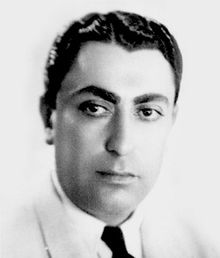Gholam Hossein Banan
Gholām-Hossein Banān ( Persian غلامحسين بنان; * May 1911 in Tehran ; † February 27, 1986 in Tehran) was an Iranian musician and singer.
Life
Gholām-Hossein's father Karim Khān Banān ol-Douleh Nurí (كريم خان بنان الدوله نوري) was a musician and calligrapher . His mother, daughter of Mohammad Taqi Mirza Rokn ed-Dowleh (محمد تقي ميرزا ركن الدوله), son of Mohammed Shah and brother of Naser al-Din Shah , was a gifted pianist. A brother and two sisters of Gholām-Hossein played tar . They received their training from Morteza Neydāvud (مرتضي ني داود), one of the most famous musicians of his time.
Gholām-Hossein was initially tutored by his parents. From the age of six he began formal musical training. Gholām-Hossein took singing, piano and organ lessons from Morteza Neydāvood, who recognized and promoted his talent early on. Other teachers of Gholām-Hossein Banān were Mirzā Tāher Ziā oz-Zākerin Rasā'í (ميرزا طاهر ضياء ذاكرين رثايي), Nāser Seif (ناصر سيف), Ali-Naghi Vaziri and Rouleghollah.
In 1942 Gholām-Hossein Banān joined the Iranian National Musicians Association. From that year his voice could also be heard on Iranian radio. Gholām-Hossein Banān became a member of the orchestra of Javād Maroufi, in which he held the position of first singer.
In 1957, Gholām-Hossein Banān became blind in one eye as a result of a car accident.
Gholām-Hossein Banān died on February 27, 1986 in the Iranmehr Hospital in Ghohak, Tehran. His recordings are still very popular today, the songs Ey Iran , Caravan and Elahe-ye Naz are legendary.
Gholām-Hossein Banān is buried in the Imamzadeh Taher cemetery in Karaj. Many artists, musicians, writers, philosophers and famous people of Iranian cultural life were buried in this cemetery. In the past few years, the tombstones of Ahmad Shamlu, Amir Nasser Eftetah and Parviz Yahaghi were smashed. In early May 2010 the grave of Gholām-Hossein Banān was desecrated.
literature
- Margaret Caton: Banām, Ǧolām-Ḥosayn. In: Encyclopædia Iranica , December 15, 1988
- D. Saburi (Ed.): Az Nur ta Nawa - Gholam-Hossein Banan, Ostad-e Awaz-e Iran. ('From the ray of light to the melody - Gholam-Hossein Banan, master of Iranian song'), Tehran 1990
- Nasser Kanani: Traditional Persian art music: history, musical instruments, structure, execution, characteristics. 2nd revised and expanded edition, Gardoon Verlag, Berlin 2012, pp. 219–221
Individual evidence
- ↑ Rokni-Qajar in Children of Mohammad Shah ( Memento of the original from September 23, 2010 in the Internet Archive ) Info: The archive link was inserted automatically and has not yet been checked. Please check the original and archive link according to the instructions and then remove this notice.
- ↑ Gholam-Hossein Banan , The eminent artists of the traditional music of Iran (بزرگان موسیقی سنتی ایران) (in Persian). [1]
- ^ Gholam-Hossein Banan (in Farsi), Mahmag.org. [2]
- ↑ Kayhan, Issue May 19, 2010 No. 1306 London
Web links
- Ey Iran, sung by Gholam Hossein Banan (Video)
- Qolamhossein Banan ( Rouhollah Khaleghi Artistic Center ).
- Gholam-Hossein Banan , The eminent artists of the traditional music of Iran .
- Gholam-Hossein Banan , Mahmag.org.
| personal data | |
|---|---|
| SURNAME | Banan, Gholam Hossein |
| ALTERNATIVE NAMES | Banān, Gholām-Hossein; غلامحسين بنان (Persian) |
| BRIEF DESCRIPTION | Iranian musician and singer |
| DATE OF BIRTH | May 1911 |
| PLACE OF BIRTH | Tehran |
| DATE OF DEATH | February 27, 1986 |
| Place of death | Tehran |
